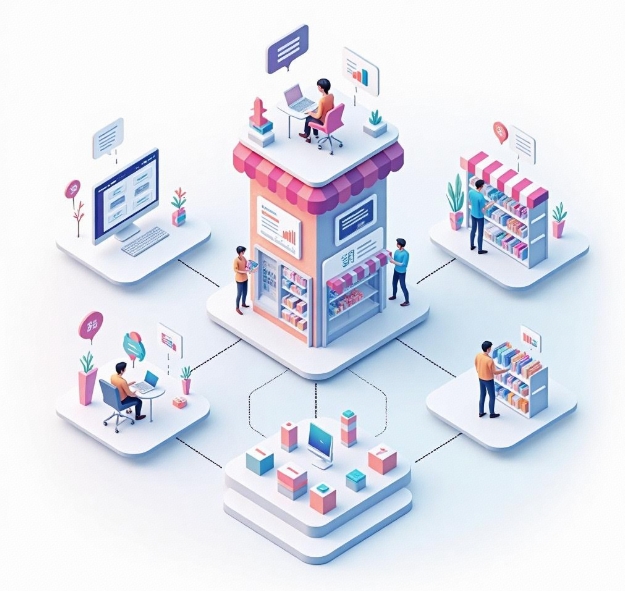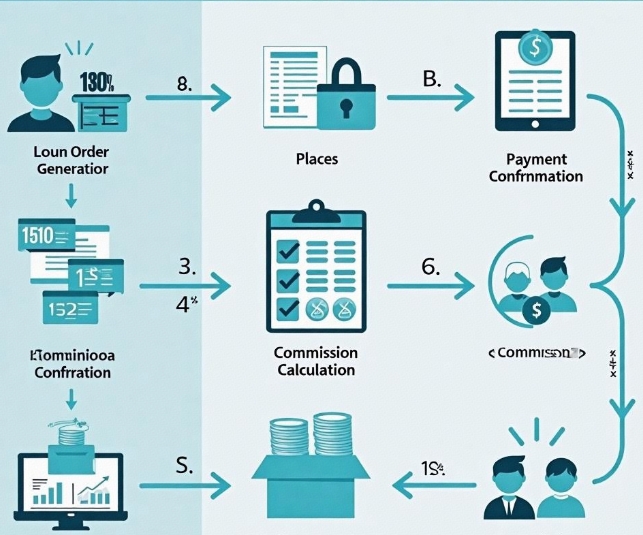Development of Multi-User Mall Profit-Sharing System in Shenzhen (Commission Settlement)
- latest articles
- 1.DApp Development & Customization: Merging Diverse Market Needs with User Experience 2.Analysis of the Core Technical System in DApp Project Development 3.How to achieve cross-chain interoperability in Web3 projects? 4.How does the tokenization of points reconstruct the e-commerce ecosystem? 5.How to Set and Track Data Metrics for a Points Mall? 6.What is DApp Development? Core Concepts and Technical Analysis 7.Inventory of commonly used Web3 development tools and usage tips 8.Development of a Distribution System Integrated with Social E-commerce 9.Six Key Steps for Businesses to Build a Points Mall System 10.What is DApp Development? A Comprehensive Guide from Concept to Implementation
- Popular Articles
- 1.Future Trends and Technology Predictions for APP Development in 2025 2.Analysis of the DeFi Ecosystem: How Developers Can Participate in Decentralized Finance Innovation 3.From Zero to One: How PI Mall Revolutionizes the Traditional E-commerce Model 4.DAPP Development | Best Practices for Professional Customization and Rapid Launch 5.Recommended by the Web3 developer community: the most noteworthy forums and resources 6.From Cloud Computing to Computing Power Leasing: Building a Flexible and Scalable Computing Resource Platform 7.How to Develop a Successful Douyin Mini Program: Technical Architecture and Best Practices 8.Shared Bike System APP: The Convenient Choice in the Era of Smart Travel 9.How to Create a Successful Dating App: From Needs Analysis to User Experience Design 10.From Design to Development: The Complete Process of Bringing an APP Idea to Life
With the rapid development of e-commerce, an increasing number of merchants and platforms are opting to operate using the multi-vendor marketplace model. Such systems not only generate higher revenue for platform operators but also incentivize users through a commission-sharing mechanism, promoting the platform's sustainable development. Shenzhen, as a forefront city for technological innovation in China, has also seen a surge in enterprises dedicated to developing e-commerce systems. This article will explore the development process of Shenzhen's multi-vendor marketplace profit-sharing system, particularly focusing on the commission settlement mechanism, and provide an in-depth analysis of its implementation methods, challenges, and development prospects.
I. Overview of Multi-Vendor Marketplace Systems
A multi-vendor marketplace is an e-commerce platform that supports multiple merchants settling in and conducting business on the same platform. Unlike traditional single-merchant e-commerce platforms, users can view products from multiple merchants within one system and make purchases based on their needs. The marketplace platform assists merchants in completing transactions by providing technical support, traffic distribution, payment settlement, and other services.
In a multi-vendor marketplace system, complex commission settlement and profit-sharing mechanisms are involved, especially when the platform needs to pay commissions to merchants, promoters, and other roles, making the design of the commission settlement system particularly important.
1.1 System Architecture
The architecture of Shenzhen's multi-vendor marketplace profit-sharing system is typically divided into front-end and back-end parts. The front-end includes operational interfaces for three roles: users, merchants, and administrators, while the back-end involves core functional modules such as order management, product management, user management, and commission settlement.
Front-end:
User Side: Users can browse products, place orders, make payments, and view their order and commission settlement information.
Merchant Side: Merchants can manage their products, view orders and sales performance, and check commission settlement records.
Administrator Side: Administrators can manage the entire marketplace system, including user management, merchant management, product management, order management, and commission settlement.
Back-end:
Order Management Module: Used to process all user order requests and record detailed information for each transaction.
Payment Settlement Module: Responsible for the payment process, ensuring smooth fund flow between merchants and the platform.
Commission Distribution Module: Calculates and settles commissions based on factors such as merchants' sales volume and promoters' referral performance.
1.2 Functional Design
The functional design of a multi-vendor marketplace mainly includes the following modules:
Product Management: Merchants can list products on the marketplace platform, setting information such as price, inventory, and promotions.
Order Management: After a user places an order, the system generates the order and handles processes such as payment, shipping, and returns.
Commission Settlement: The system settles commissions based on the transaction status of orders and according to the agreed proportion with merchants.
Statistical Analysis: The marketplace platform needs to collect and analyze sales data, user behavior data, and commission settlement data to provide decision support for platform operations.
II. Commission Settlement Mechanism
The commission settlement system is a crucial part of a multi-vendor marketplace. It not only affects merchants' profits and the platform's revenue but also directly influences user activity and promotion enthusiasm. Therefore, designing an efficient and fair commission distribution mechanism is essential for the success of the marketplace platform.
2.1 Commission Distribution Principles
In a multi-vendor marketplace, commission distribution typically follows these principles:
Transparency and Fairness: Commission settlement should be based on clear rules without hidden fees. Merchants and promoters should be able to clearly see the source and calculation method of commissions.
Proportional Distribution Based on Sales: Generally, commissions are distributed based on a certain percentage of sales. For example, for each completed transaction, the platform may take a certain percentage as commission, with the remainder paid to the merchant or promoter.
Promotion Incentive Mechanism: To incentivize users to promote the marketplace, the platform can establish a promoter system where promoters earn commissions based on their promotion effectiveness. Typically, promoter commissions are linked to the sales generated from their promotions, and the settlement cycle can be daily, weekly, or monthly.
2.2 Commission Settlement Process
Order Generation: When a user successfully purchases a product, the system generates an order and records the relevant transaction data.
Payment Confirmation: After the payment process is completed, the system confirms the order amount and prepares to begin commission settlement.
Commission Calculation: Based on the platform's commission rate or the promoter's contribution, the system automatically calculates the commission.
Commission Settlement: Commission settlement is carried out according to the cycle set by the merchant, and the system pays the commission to the merchant's or promoter's account.
2.3 Complexity and Challenges of Commission Settlement
In actual development, the commission settlement system may face the following challenges:
Multi-Level Profit-Sharing Mechanism: In some complex marketplace systems, commissions may need to be distributed across multiple levels. For example, the platform may need to allocate commissions to merchants, promoters, agents, and other parties simultaneously. Designing a clear hierarchy and ensuring settlement accuracy is a major challenge in development.
Data Real-Time Requirements: Commission settlement relies on real-time transaction data, which is often vast and complex. Ensuring real-time data processing and accurate settlement is a technical difficulty.
Settlement Cycles and Financial Integration: Different merchants and promoters may have different settlement cycles. Balancing the needs of multiple parties and integrating with financial systems requires thorough consideration during system design.
2.4 Technical Implementation
The development of a commission settlement system relies on modern technological architecture. Common technology stacks include:
Front-end: Using frameworks like React or Vue to implement the user, merchant, and administrator interfaces of the marketplace.
Back-end: Employing development languages such as Java, Python, or Node.js, combined with databases like MySQL or MongoDB for data storage and processing.
Settlement Module: Can use scheduled tasks (e.g., Quartz) to periodically calculate commissions or trigger settlements based on real-time data.
III. Shenzhen's E-commerce Market and the Prospects of Profit-Sharing Systems
As one of China's most important cities for technological innovation, Shenzhen boasts abundant technical resources and e-commerce infrastructure. Many innovative companies choose to establish R&D centers in Shenzhen, providing strong support for the development of multi-vendor marketplace systems. Shenzhen's e-commerce industry is developing rapidly, with various online marketplace platforms flourishing. Particularly in the area of profit-sharing mechanisms, Shenzhen enterprises continuously explore new technologies and business models, driving constant innovation in commission settlement systems.
3.1 The Rapid Rise of Shenzhen's E-commerce Industry
Shenzhen's e-commerce industry has grown rapidly, especially in the fields of mobile e-commerce and social e-commerce, giving rise to a large number of successful enterprises. These companies not only promote economic development in the Shenzhen region but also provide rich scenario demands for technological innovation in e-commerce systems. As e-commerce platforms gradually mature, the importance of commission settlement systems becomes increasingly prominent, forming the core of e-commerce platforms' profit models.
3.2 Future Development of Profit-Sharing Systems
With the continuous deepening of the multi-vendor marketplace model, the functions of commission profit-sharing systems will further expand. Future profit-sharing systems will become more intelligent and flexible, supporting more complex profit-sharing rules and more precise financial analysis. Meanwhile, emerging technologies such as blockchain may bring more innovation to commission settlement, enhancing transparency and efficiency across the entire e-commerce industry.
Conclusion
The development of Shenzhen's multi-vendor marketplace profit-sharing system, particularly the commission settlement module, is not only a technical challenge but also an opportunity for business innovation. By designing a reasonable commission distribution mechanism, merchants and users on the platform can be effectively incentivized, promoting the platform's healthy development. With continuous technological advancements, future commission settlement systems will become more refined and intelligent, bringing greater value to e-commerce platforms and users.
-

How does the tokenization of points reconstruct the e-commerce ecosystem?
With the continuous advancement of internet technology and the gradual prolifera···
-

How to Set and Track Data Metrics for a Points Mall?
With the rapid development of the e-commerce industry, points malls, as a common···
-

Development of a Distribution System Integrated with Social E-commerce
With the rapid development of internet technology, the e-commerce industry has e···

 Blockchain
Blockchain












